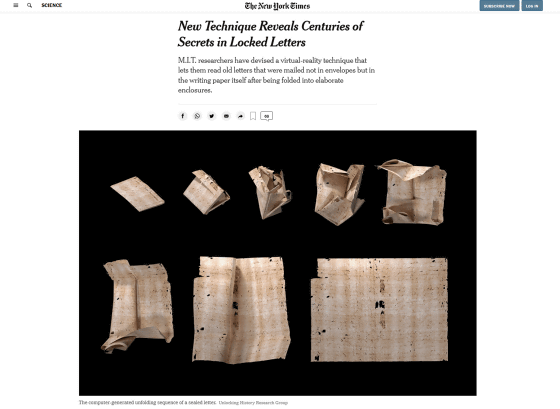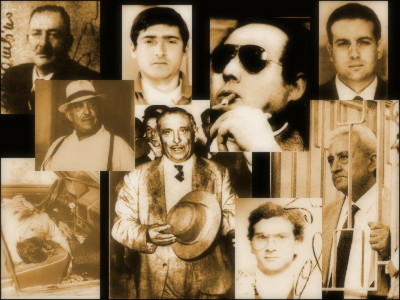Succeeded in virtually opening a letter sealed by a special method over 300 years ago with an X-Ray Scanner

by Unlocking History Materials Collection
Unlocking history through automated virtual unfolding of sealed documents imaged by X-ray microtomography | Nature Communications
https://www.nature.com/articles/s41467-021-21326-w
Secrets of sealed 17th century letters revealed by dental X-ray scanners | EurekAlert! Science News
https://www.eurekalert.org/pub_releases/2021-03/qmuo-sos030121.php
“Locked” for 300 years: Virtual unfolding has now revealed this letter's secrets | Ars Technica
https://arstechnica.com/science/2021/03/locked-for-300-years-virtual-unfolding-has-now-revealed-this-letters-secrets/
New Technique Reveals Centuries of Secrets in Locked Letters --The New York Times
https://www.nytimes.com/2021/03/02/science/locked-letters-unfolding.html

Letter locking is a technique that folds a letter, cuts off a part of it, or partially secures it with a string or wax to seal it so that someone can read it while it is being delivered. The history of letter locking in Europe dates back to the 13th century, and it was used by many people until the appearance of mass-produced envelopes in the 1830s.
Celebrities such as aristocrats such as Mary I and Elizabeth I , thinker Niccolo Machiavelli , and scholar Galileo Galilei are known to have sealed their letters by letter locking. In addition, letter locking was used not only by celebrities but also by the general public who have a habit of writing letters.
Over the centuries of history, letter locking has taken many forms. According to Jana Dambrogio, who studies letter locking at the Massachusetts Institute of Technology (MIT), there are hundreds of forms of letter locking, some simple and some very complex. Depending on the person, he may use his own letter locking, which he developed independently, and he was able to show the individuality of the sender by how to seal the letter.

by Unlocking History Materials Collection
However, the bottleneck in letter locking research is that the letter will be damaged if it is opened to check the type and contents of the letter locking. In some cases, opening the letter could result in the loss of clues to the technology used for letter locking, Dambrogio said, 'We really need to keep the original. We closed the sealed letter. If you leave it alone, you can continue to learn from it. '
So an international research team, including Dambrogio, devised a method for reading letters sealed by letter locking using a high-sensitivity X-ray microtomography scanner developed at the Dental Institute at Queen Mary University of London. .. It seems that this scanner was designed for the purpose of mapping the mineral content in teeth, but it also works with ink contained in old paper and parchment.
In addition, the research team has also developed an algorithm that separates the layers of folded letters, virtually expanding letters sealed by letter locking, and making it possible to investigate how to fold letters. 'This scanning technique is similar to a medical CT scanner, but by using more powerful X-rays, the ink used to write the letters,' said David Mills, co-author of Queen Mary. You can see the fine traces of the metal contained in it. '
The research team, which developed a new method using the X-Ray Scanner, tried to decipher the letter in the trunk of the Post Museum in The Hague, the Netherlands. A total of 2,571 letters were written between 1689 and 1706, but were not delivered for some reason. In addition, 577 of the total have been sealed by letter locking and have been kept unopened to this day.

by Unlocking History Materials Collection
The research team analyzed 4 out of 577 letters with an X-Ray Scanner and succeeded in reading the contents of the letter for the first time in 300 years. One of the letters examined in this study was sent from Lille, France to The Hague on July 31, 1697, with a request to send a copy of the death notice. That thing.

by Unlocking History Materials Collection
The research team pointed out that the investigation of letters sealed by letter locking could advance research on local culture, postal networks, and the history of letter locking. 'This algorithm guides us to the heart of a locked letter.' 'Using virtual expansions to read personal stories that are neither seen in the light nor reachable to the recipient. Is really great. '
Related Posts:
in Science, Posted by log1h_ik







